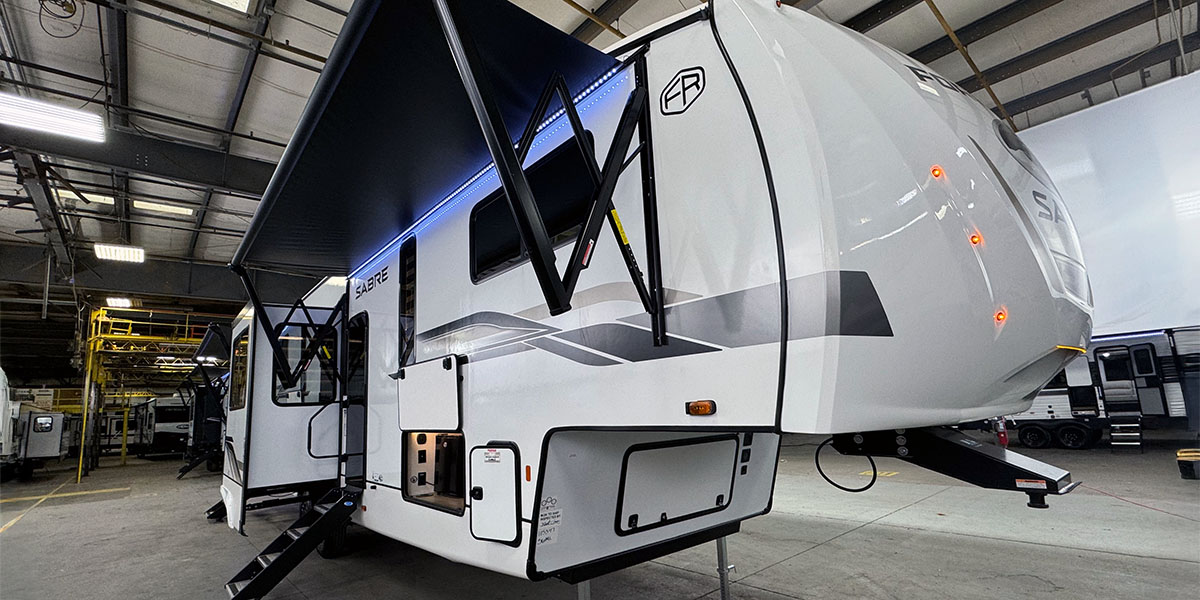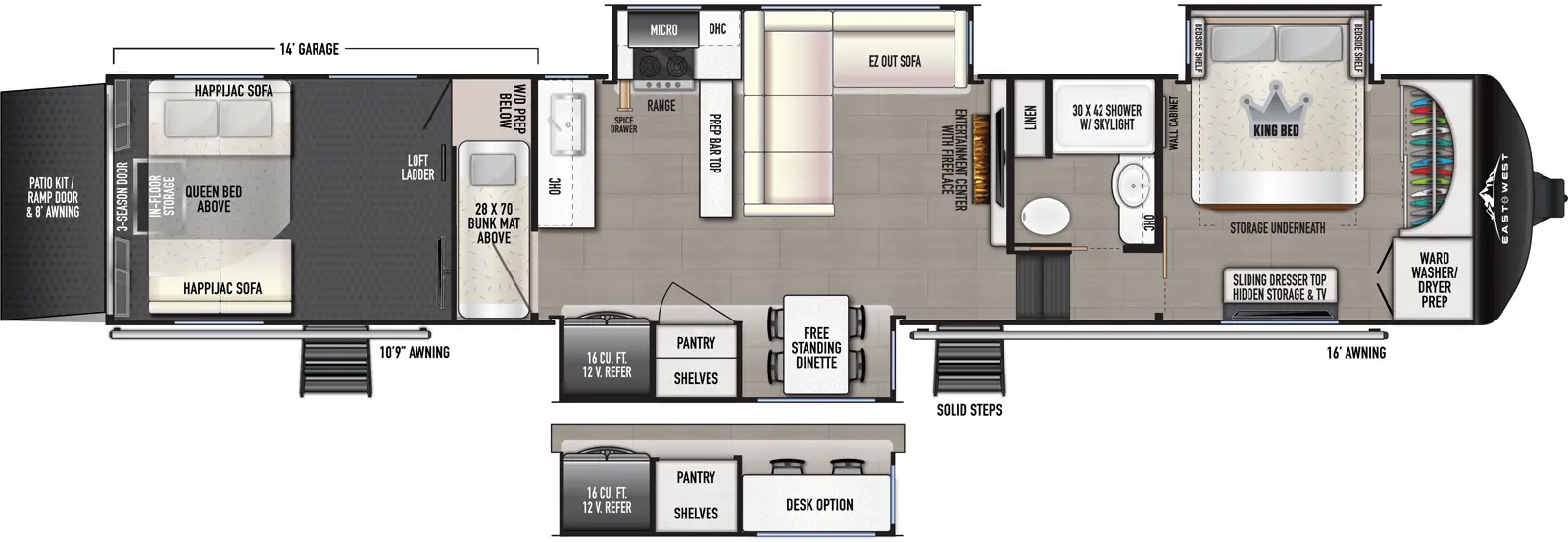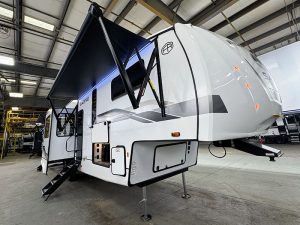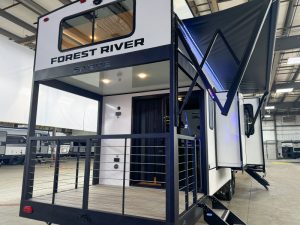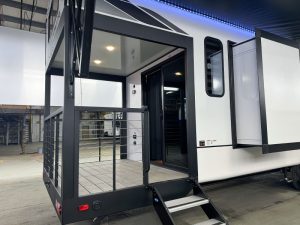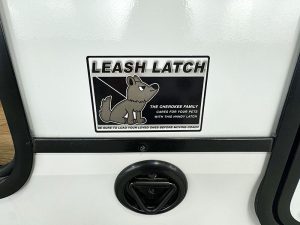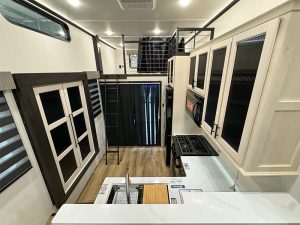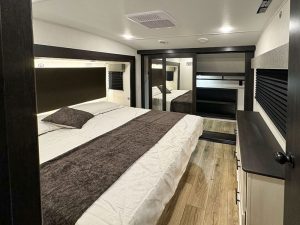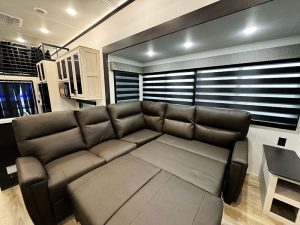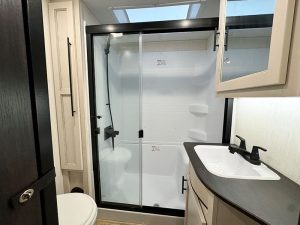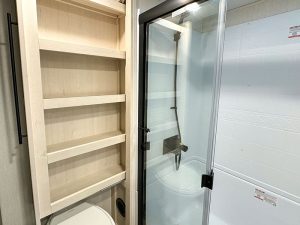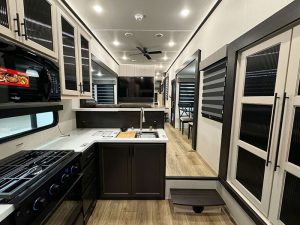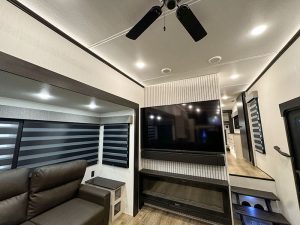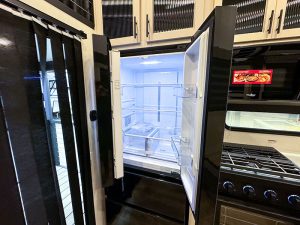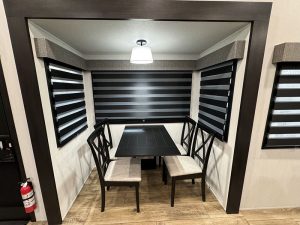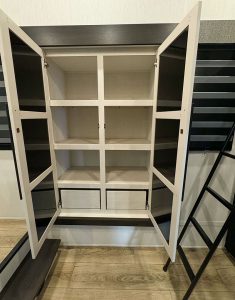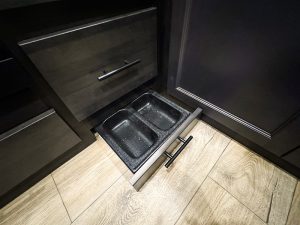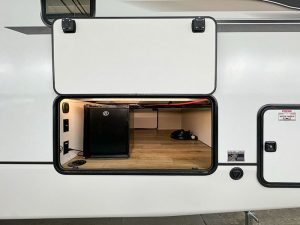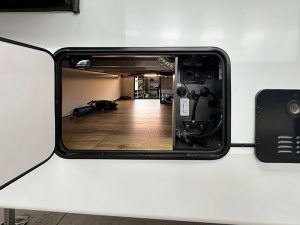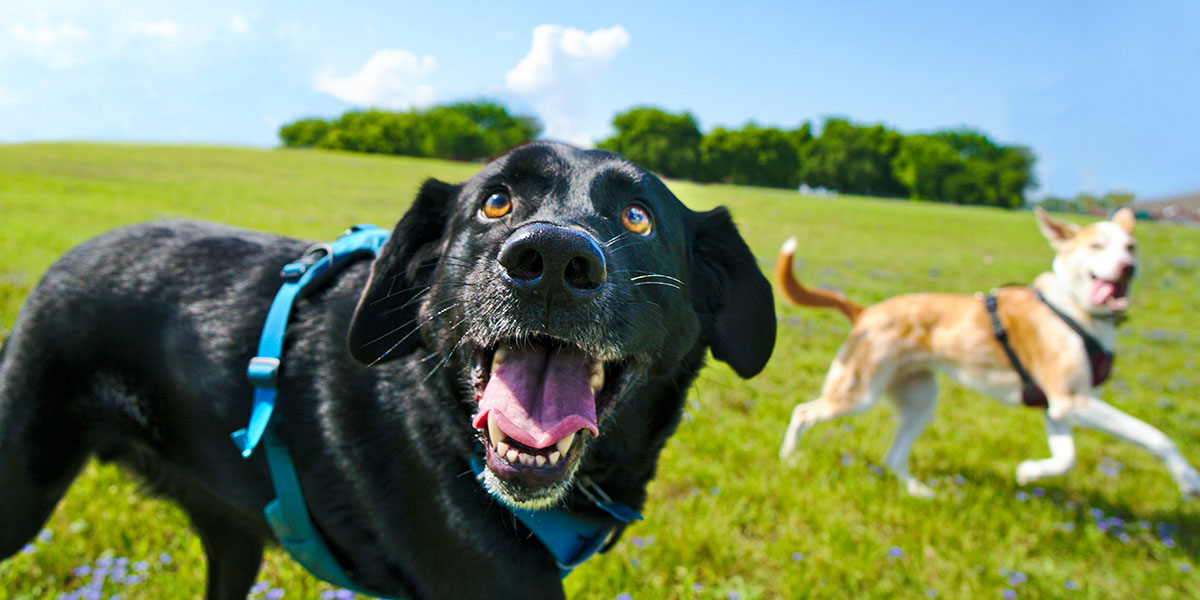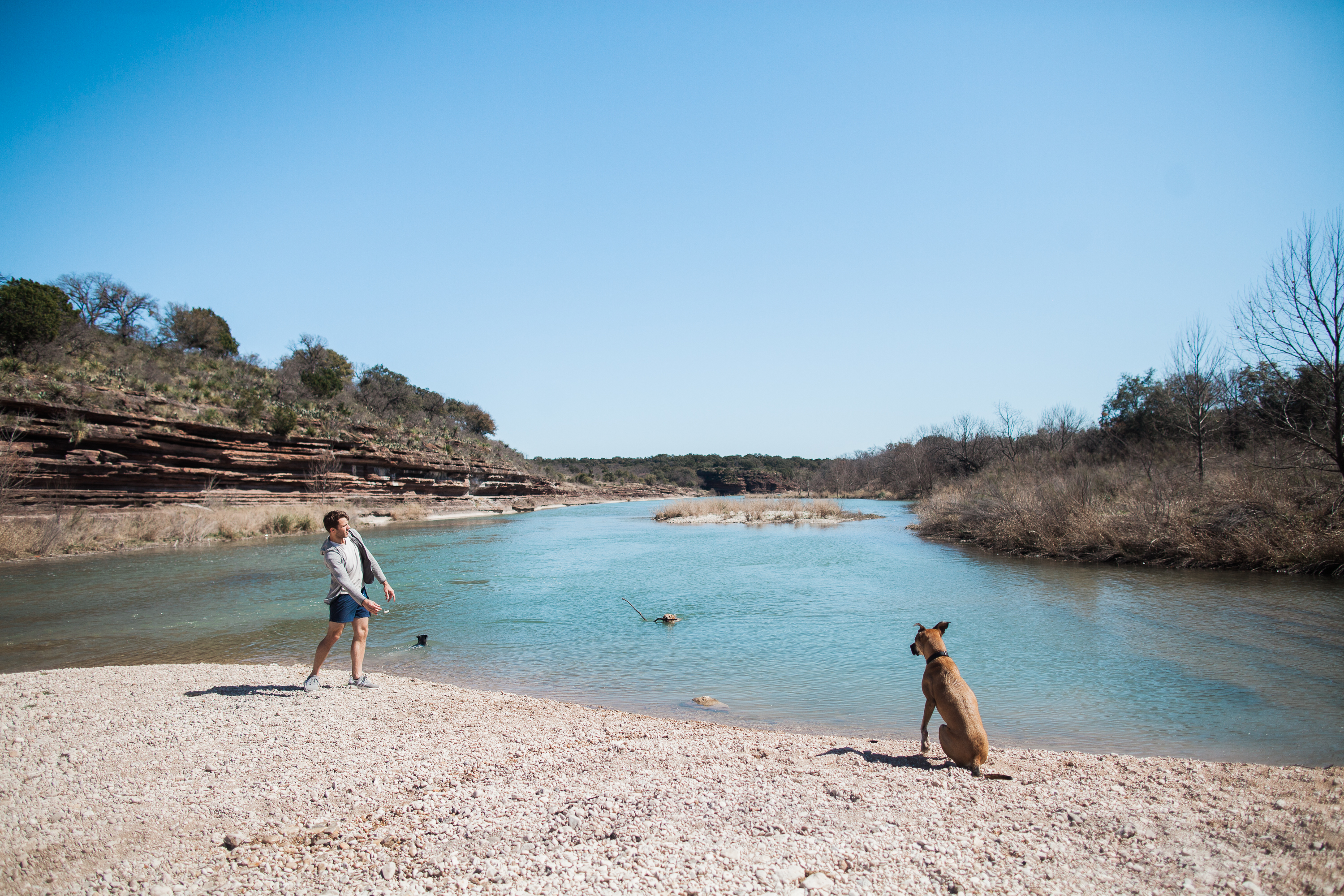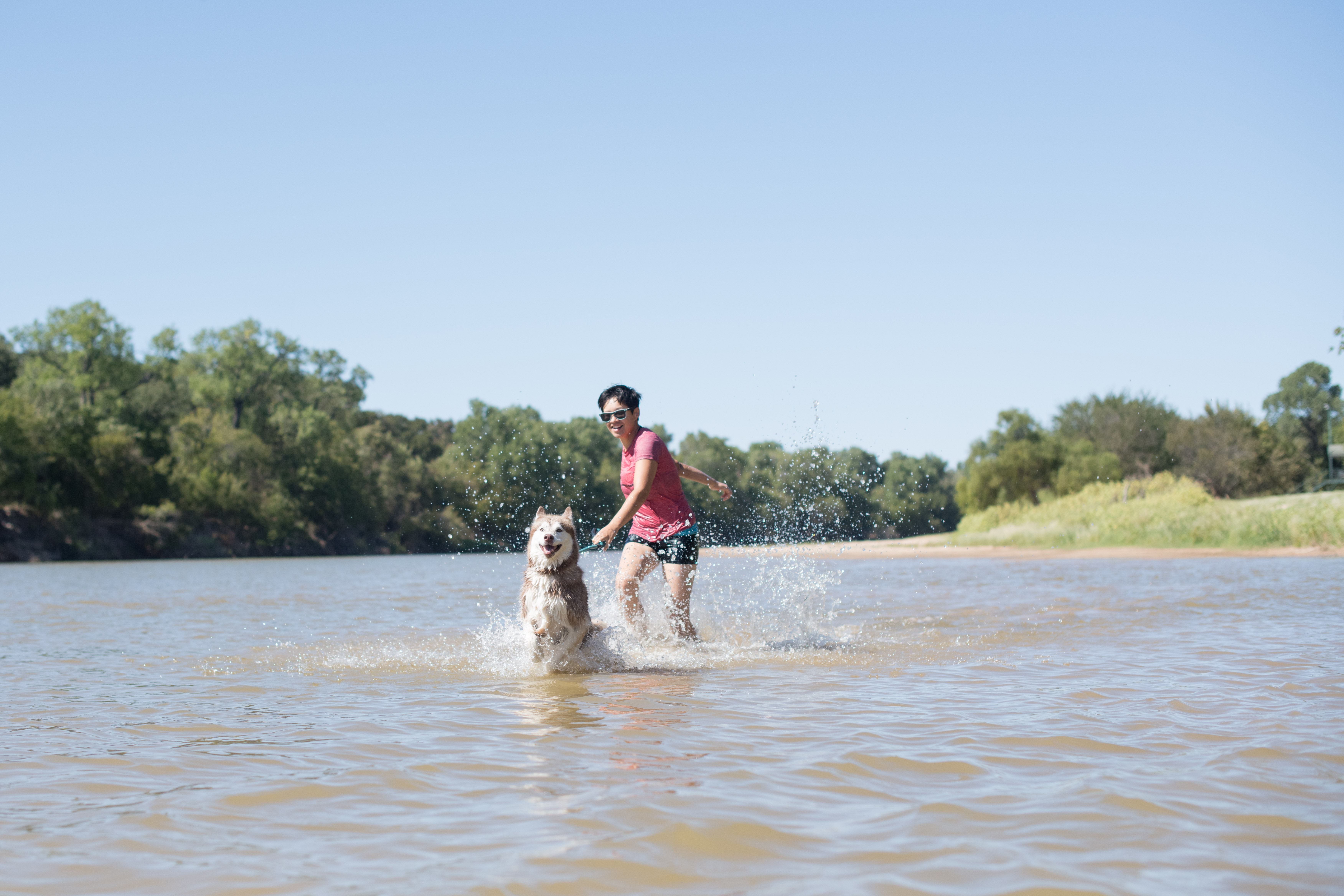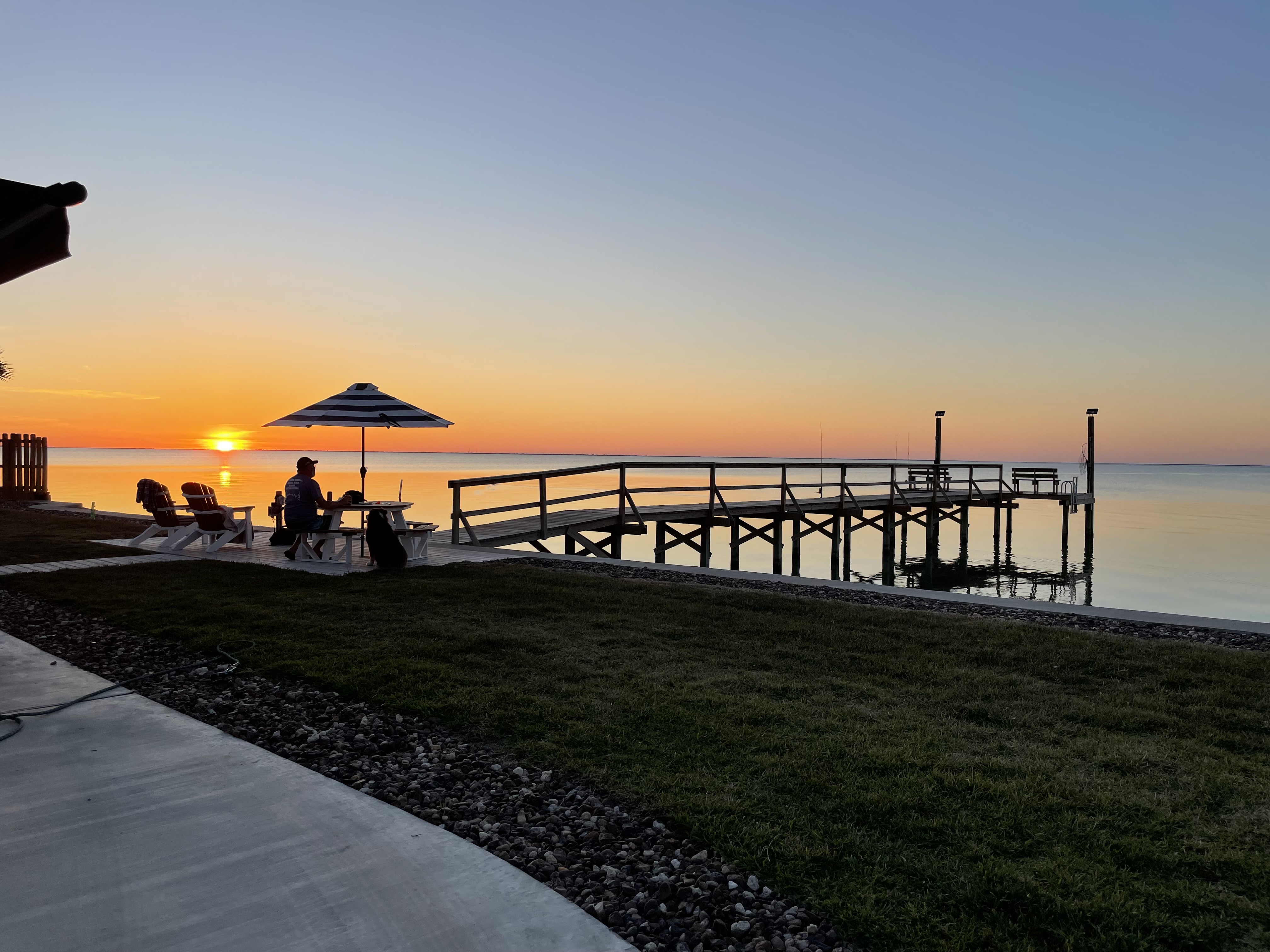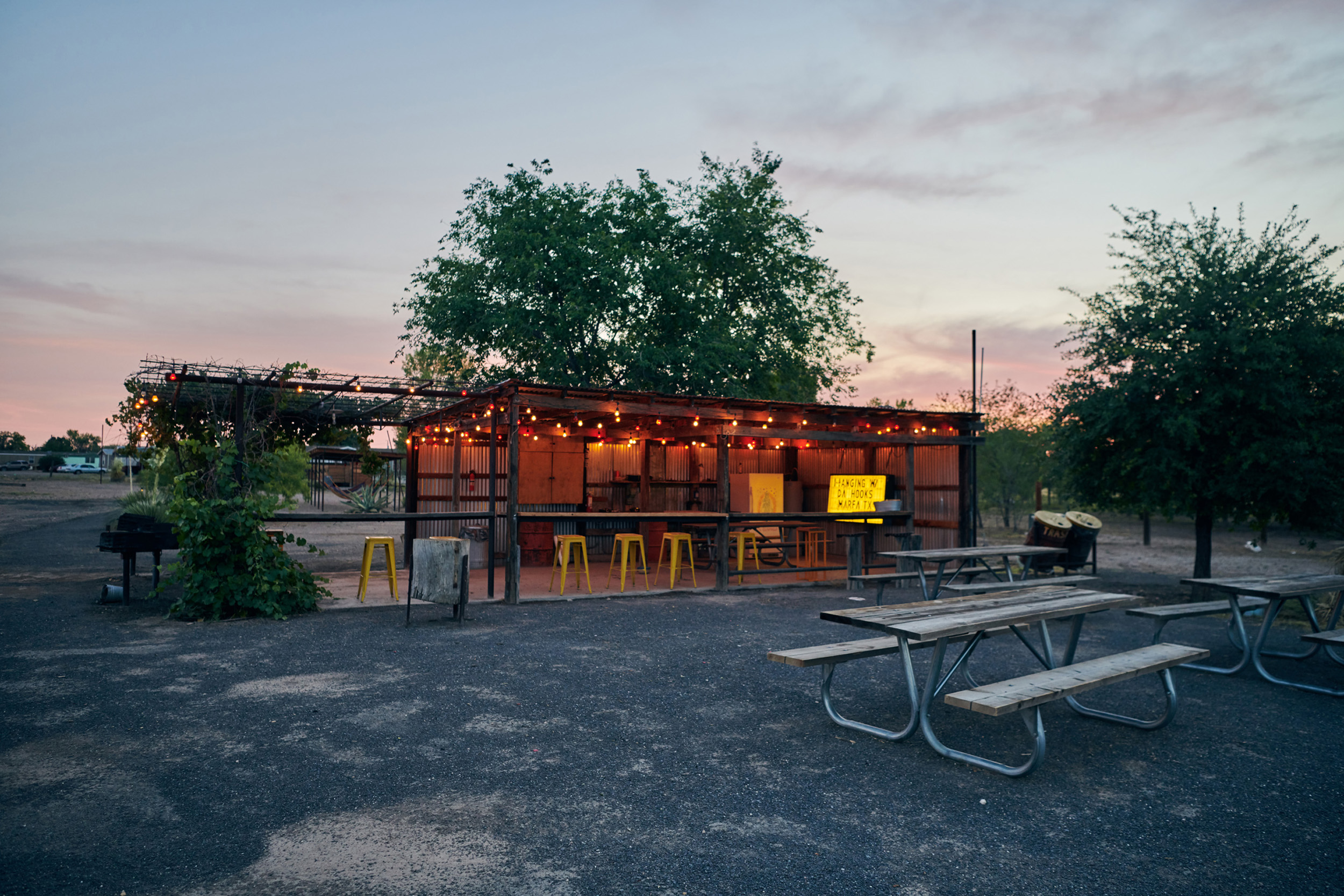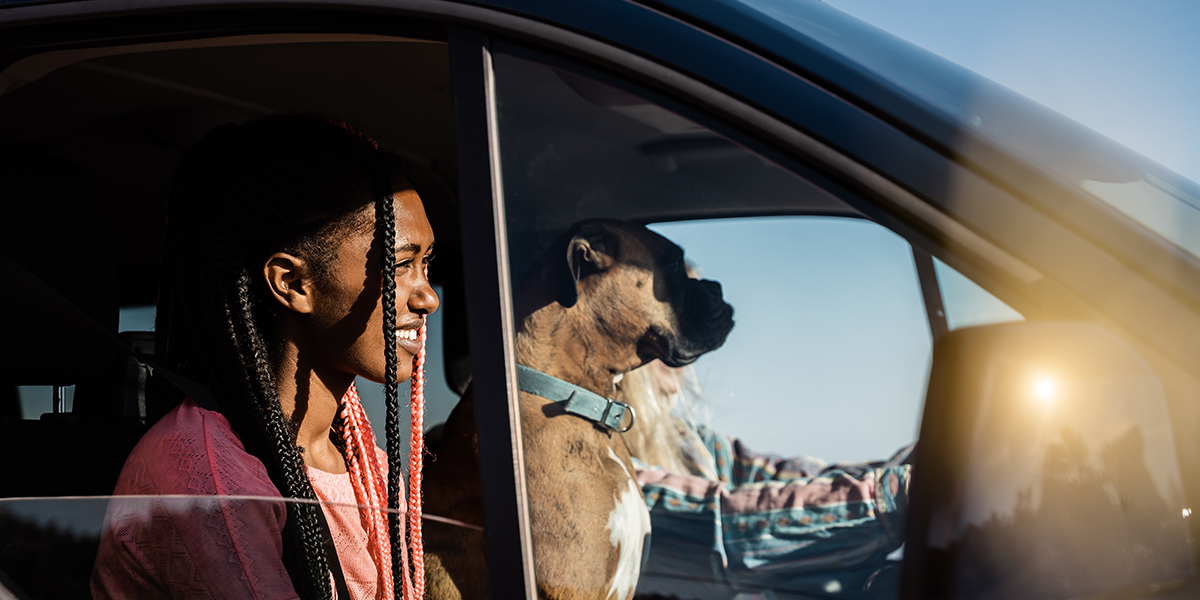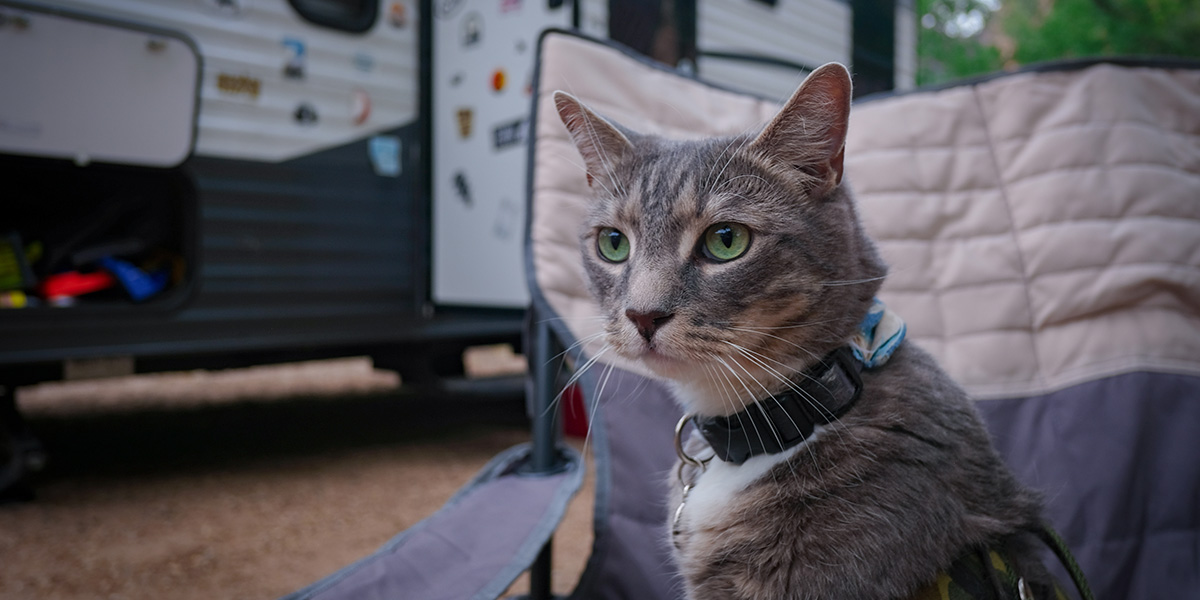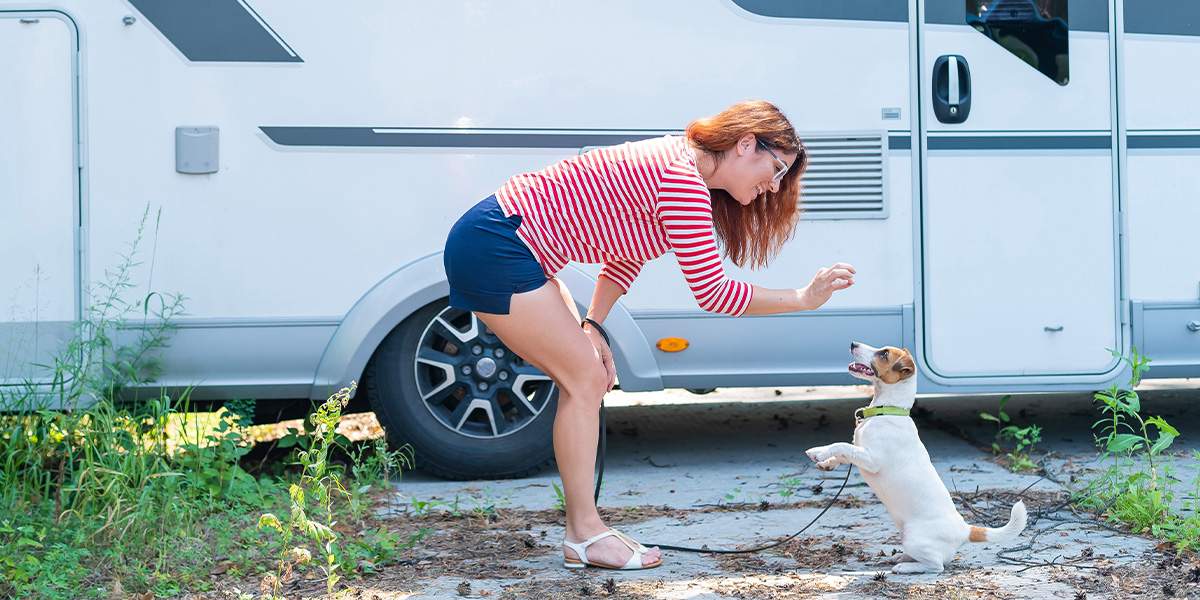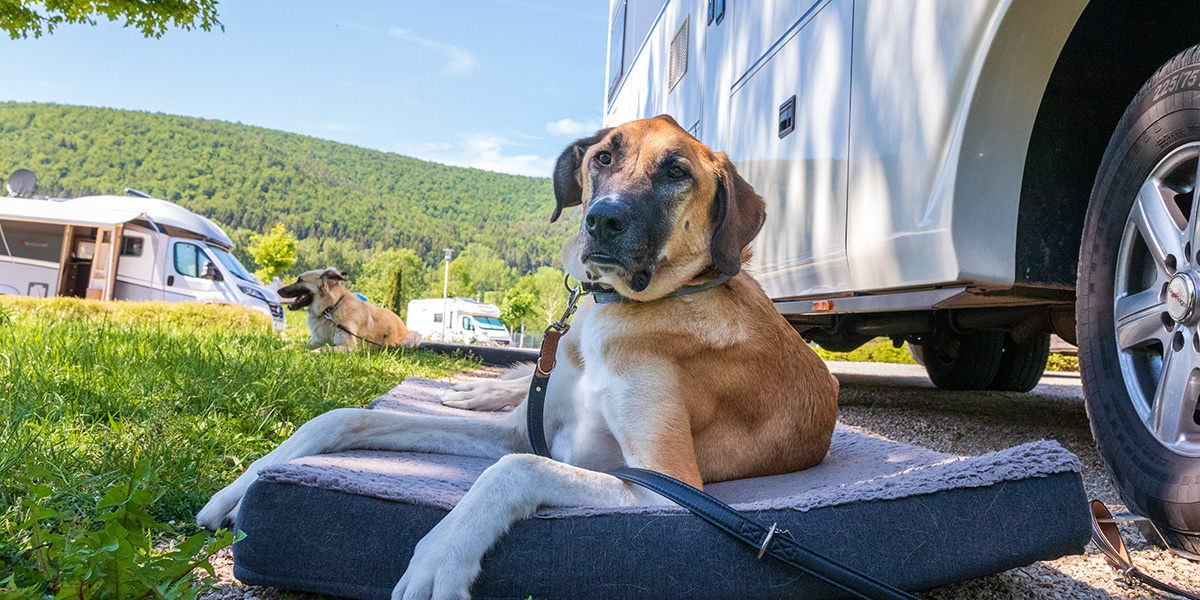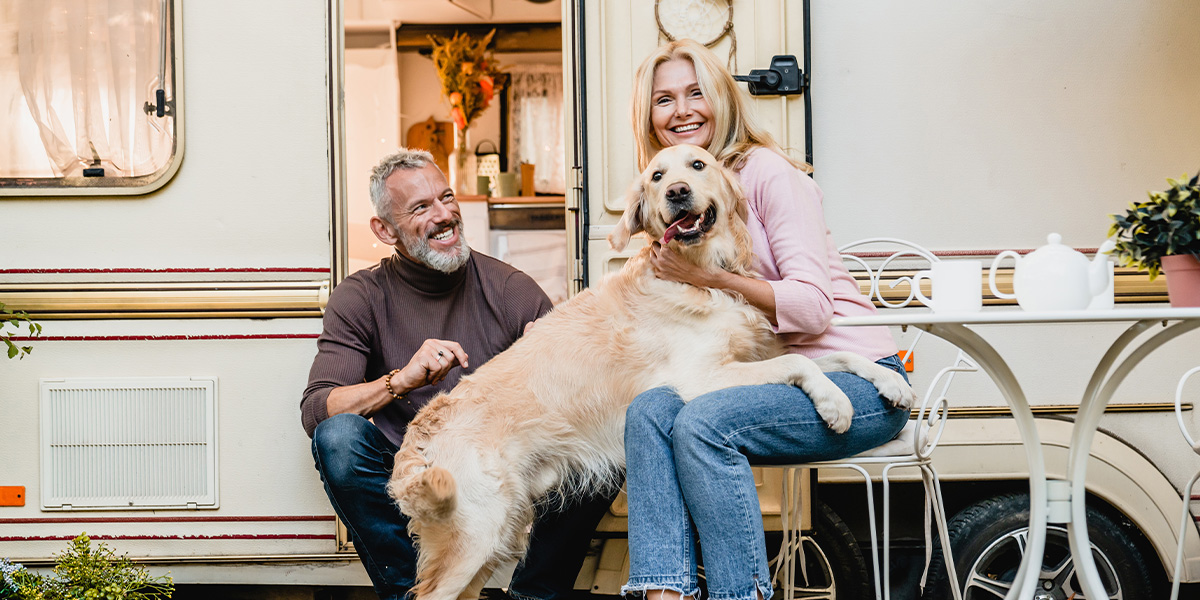There’s luxury, and then there’s the Sabre 36ML. Fifth wheels are known for bringing decadence to RV living. But this model offers big doses of luxury as well as small thoughtful touches that make life on the road a thing of beauty. Built with your traveling family in mind, everyone can enjoy the great outdoors with the luxuries – and space – of home.
At a Glance: Sabre 36ML
I gave the Sabre 36ML 8.5 out of 10 – I loved it. It wows you with its clever use of space. You don’t need a 40-foot fifth wheel to feel like you are in a spacious rig; and it’s all in the head room.
If you are looking for an RV, but feel somewhat claustrophobic in small spaces, consider this unit. The roomy kitchen has an almost vaulted ceiling effect. Your kids and pets will thank you, with an overhead bunk suite above a decadent porch. Oh yes, you heard right, I said porch.
[review_summary class=”custom-class” title=”2025 Forest River Sabre 36ML” description=”This score is awarded by an expert reviewer conducting an independent assessment of the RV.”]
Check the Specs
- Sleeping capacity: 6
- Hitch weight: 1,925 pounds
- UVW: 12,158 pounds
- CCC: 2,800 pounds
- Exterior length: 43 feet 2 inches
- Exterior height: 13 feet 5 inches
- Exterior width: 8 feet
- Fresh/Gray/Black: 49/76/38 gallons
- Propane: 2 x 20-pound tanks
- Awnings: 11-foot and 15-foot awnings
- MSRP: Starting at $85,000
Features We Love
- Tall ceilings
- A spacious top-floor room for kids or visitors
- Ample storage in the kitchen and master bedroom
- Built-in porch
- Tasteful, and safe railings on porch and loft
- Surprise cabinet in bathroom
Benefits
- Bring your kids: No need to cram them into a tiny bunk room, they can have their own loft space.
- Pack your entire home kitchen: A bevy of culinary storage means you don’t need to leave anything behind.
- Your dogs will be happy and safe. They’ll enjoy the fenced-in porch area and stay safe with tie points.
Challenges
- You’ll want to stay a while: Your trips may end up a bit longer than planned with so many comforts and so much space.
- Unfurnished loft: For real though, you will need to supply your own bed(s) in the loft space.
- One weird flaw: The blinds in the kitchen are difficult to deploy, and came off their hangers pretty much immediately. These will need to be replaced if you want to avoid some foul language in the kitchen.
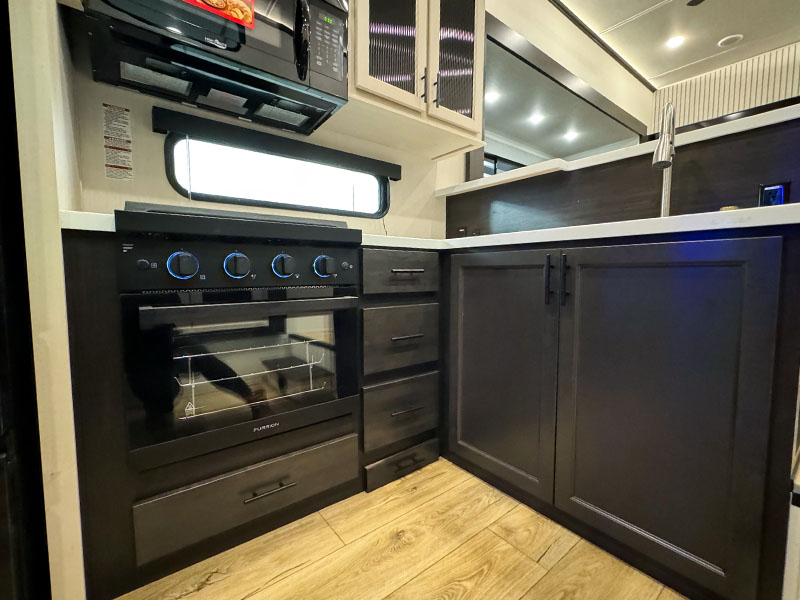
Best For
- Traveling families. In particular those that want to live full time on the road or have extended vacations in a luxurious, and spacious (but not too big) rig.
- Pet lovers. The porch is practically made for their fur babies.
- Culinary experts. The fantastic kitchen has room to store all your ingredients and the tools you need to prepare them.
Key Areas We Evaluate for RV Buyers
Sleeping Space
Loft Space
Just like the rest of this unit, the sleeping space will wow you. Situated above the porch is a large loft area perfect for kids. A removable ladder is attached for safe access, with a durable and sleek railing all around it. There are no storage options here, but plenty of space to make your own, depending on the size of the bed, or beds, you want to include. There are two sets of outlets and charging ports in the loft, with a curtain for privacy.
If you have any early risers in the family, make sure they are quiet while they make their coffee and breakfast, so as to not disturb whoever is sleeping in the loft space.
Master Suite
Situated at the nose of the trailer, an elegant master suite will greet you with a king-size bed. The space is definitely roomy, with plenty of space to walk around the bed and utilize the dresser at the foot of it. There isn’t a convenient place on either side of the bed for books or devices, but there is a large cabinet disguised as a headboard. You can’t access this storage for devices while you are resting comfortably in the bed, however.
The closet has three sliding doors, each with a full-size mirror attached, accentuating the spacious design. Inside the closet is a 7.5-foot-long shelf that spans the upper portion for general item storage, while a rod runs underneath it for hanging clothes. A large inset double shelf is perfect for shoe storage. There is also a washer and dryer hook up here. I can’t think of anything that makes RV life more convenient than a washer and dryer.
At the foot of the bed is a large dresser with four drawers beneath a wide window. There is an option for installing a ceiling-mounted television above the dresser. The bed offers a large area for storage beneath the mattress, with easy-to-lift gas assist struts.
Conversion Bed
In the living area, there is a sizable L-shaped couch. One side of the couch pulls out with ease into a double-size bed. This would be great for a guest if there isn’t space in the loft, or if they would rather forgo climbing up the ladder to access that space.
Bathroom
The only downside to the Sabre 36ML’s bathroom is that there is only one. But if you don’t mind sharing with kids or visitors, then it won’t be an issue. The bathroom boasts luxury throughout, with a porcelain foot flush toilet and lovely glass sliding doors on the shower.
The shower has a bench with the insert, and three basic shelves. A skylight adds natural light to your showering experience. The sink is basic, with a medicine cabinet above for storage, and a cabinet below. There are two GFCI outlets next to the sink with counter space to rest your appliance or device on. A towel rack or hook would be a nice addition somewhere in this space.
A surprise feature lives behind the toilet. What I thought was a small storage compartment revealed a hidden pull-out cabinet on a track that slides out almost the full width of the bathroom. Three large shelves are available for a variety of bathroom product storage here.
Living Area
The windows in the living space make for an inviting and airy interior. And speaking of windows, one of my favorite details of this fifth wheel are the shades. They are zebra windows shades that seamlessly alternate from black out shades, to a lighter shaded option, or nothing at all. I can imagine myself having fun playing with the natural light in this space. Accent LED strip lighting offers a warm glow, with tasteful pendant lighting over the dinette and flush lighting in the ceilings.
The dinette is tucked in a slide, with seating for four and surrounded by windows. An L shaped couch with reclining sets will comfortably seat five, across from a whopping 60-inch TV. If you don’t plan to spend all your time outside, worry not, there is plenty to keep you entertained and comfortable inside this rig.
There isn’t a whole lot of storage in the living space. But other areas more than make up for that. The entertainment center under the TV has some shelving, and the ottoman opens to reveal a large amount of storage as well. There are two open cubbies as part of a built-in end table in the corner of the space, at the far end of the couch.
The Deck
If it starts getting a little stuffy inside, you can lounge on the covered deck of the Sabre 36ML. On the far end of the kitchen are large double doors that slide open to the deck space. This is great for small wandering children or dogs. And speaking of dogs, there are latches attached to the rig for your traveling-with-pets convenience. The railing here is sleek and airy, made with black railings and taut steel cables.
Kitchen
The kitchen space is a gem. Truly. If the kitchen is your sacred space, then you should have a closer look at this unit. For traveling families especially I think it is important to prioritize the feasibility of meal times. In this kitchen, no stone was left unturned. The high ceilings mean you can really spread your wings. Nothing makes me feel more cramped than when I’m trying to cook in a tiny RV kitchen. All of the appliances are residential, including an enormous 12V refrigerator, with two freezer drawers that pull out beneath it. Just imagine, you could have an entire freezer drawer devoted to ice. Your cocktail skills will thank you.
A large farmhouse-style sink has various interchangeable cutting boards, dish racks, and sink basins for multiple uses, and a tall pull-down faucet nozzle. There is a vegetable rinser, soap dispenser, and a glass cleaner. Acres of countertop space area available for all your food prep. No sacrifices need be made to cook (or live) in this RV.
The microwave has a convection feature, but you will probably do most of your baking in the large oven under the three-burner range. Outlets are available throughout the space, along with charging ports. Above the sink is a ledge that would be perfect for plants or other decorations. You know you’ve hit the jackpot when you have space for decorative items, and not just functional things.
Okay, storage – where to start? There’s a good chance that this kitchen has more cabinet space than your kitchen at home. I could probably fit my entire body in the under-sink cabinet. The overhead cabinets go way up in these tall ceilings, so they offer towers of space. (But you might want to have a kitchen stool handy to reach them.) And across from the oven is a 40-inch wide, four-foot tall, two-door pantry with three divided shelves and two drawers beneath it. All this storage space makes me drool. And for pets, there is a discreet little food and water station underneath the drawers by the oven.
Four-Season Capabilities
The Sabre 36ML offers a range of features that can extend your camping season. The PVC roof is sturdy and will help withstand the weight of snow and ice. PVC is gaining popularity among newer RVs, thanks to its enhanced durability.
Two awnings with LED accent lighting will ensure you and your kids or pets stay cool under a hot sun. The solar-reflective windows will help keep the warmth of the sun outside. And the dual 30,000-BTU AC units are whisper-quiet, so you won’t have to shout over the noise while you’re inside.
In the cold, you can rest easy knowing that the heated enclosed underbelly will be less susceptible to freezing pipes. Forced air in the underbelly will protect critical components. The on-demand tankless water heater will also conserve water through recirculation, and will ensure that your showers are warm when the weather is not.
Storage Space
The storage space is a highlight in the Sabre 36ML. The master bedroom has an abundance of places to put things. And the kitchen! The kitchen has more storage than I would know what to do with. There are a few cabinets without doors, however, in the living space. Outside of the unit there is a pass-through storage area with a fridge inside for a small mini kitchen! The docking station is inside the pass-through storage area, and includes the black tank flush and an outdoor shower.
Chassis/Suspension
The Sabre 36ML is constructed with a lightweight, yet robust frame. The manufacturer’s intention is to provide a durable and stable towing experience. The suspension is a traditional leaf spring system. The tires are fitted with aluminum wheels, and EZ lube hubs. There are electric drum brakes on both axles. An electric auto-leveling system will make set up much easier. Tire pressure safety sensors will also cut down on your maintenance time, and enhance your family’s safety on the road.
Off-Grid/Sustainability
200 watts of solar on board will entice you to take this rig off the grid. The tankless water heater will help conserve your fresh water in the 50 gallon tank by recirculating the cold water until the warm water heats up. The 12V refrigerator operates efficiently on battery power, minimizing your need for electrical hookup. Two 20-pound tanks are included, but there is space for 30-pound tanks to extend your boondocking trip. But before you go off-roading in your fifth wheel, make sure you have clearance under the rig. The drop frame in the back might make it a little difficult to go over any sizable bumps in the road.
Build Quality
Solid-surface countertops, lumbercore cabinets, strong and tasteful railings, and high-quality frame construction are just a few examples of the build quality in this rig. The walls are vacuum-bonded for integrity and durability. The process involves placing layers of materials under vacuum pressure to create a strong, unified bond. This process also helps to insulate and regulate temperature inside the rig in more extreme weather.
Value
The Sabre 36ML varies in price, ranging from $85,000 to over $110,000. Many dealers offer hefty discounts, making this model more attainable to some. I think the price is pretty competitive considering the functional floor plan, build quality, and kitchen/living amenities. If it had two bathrooms I would give it a 9 or 10.
Closing Notes on the Sabre 36ML
Fifth wheels have so much to offer couples and families that want a sustainable model of adventure. A delicate balance of luxury and functionality weaves a beautiful picture of what life could look like on the road. Nothing was left out of the mix, not your kids, or even your furry companions. This rig was made for everyone’s comfort.
A Note on the RV Trader Review Process
RV Trader asked RV shoppers what was most important to them in their RV buying process. Potential buyers — like you — helped us to identify a list of six key areas that camping and travel enthusiasts always look at when they’re searching for the perfect RV: sleeping space, bathroom, living area, four-season capabilities, and storage space.
The RV Trader team then got to work providing you with honest and unbiased evaluations. If you’re wondering, that’s where I came in. As an RV expert and enthusiast, I provide an honest look at RVs from an RV industry insider perspective.
Make Your Move
Start shopping for the year, make, and model. Find Your Sabre
[marketplace_inventory_widget]
What Other Campers Are Saying
Read the best reviews by owners. Search for an RV Model
